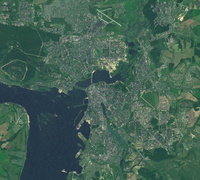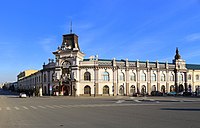Kazan
Kazan Казань | |||
|---|---|---|---|
City of republic significance[1] | |||
| Other transcription(s) | |||
| • Tatar | Казан | ||
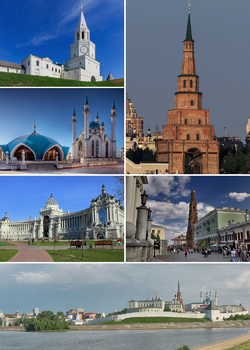 Left to right, top to bottom: Spasskaya Tower, Söyembikä Tower, Qol Sharif Mosque, Farmers' Palace, Epiphany Cathedral, view of Kazan | |||
| |||
Location of Kazan | |||
 Kazan Location of Kazan Show map of Russia  Kazan Kazan (Tatarstan) Show map of Tatarstan | |||
| Coordinates: 55°47′47″N 49°06′32″E / 55.79639°N 49.10889°E / 55.79639; 49.10889Coordinates: 55°47′47″N 49°06′32″E / 55.79639°N 49.10889°E / 55.79639; 49.10889 | |||
| Country | Russia | ||
| Federal subject | Tatarstan[1] | ||
| Founded | 1005[2] (see text) | ||
| Government | |||
| • Body | City Duma[3] | ||
| • Mayor[4] | Ilsur Metshin[4] | ||
| Area [5] | |||
| • Total | 425.3 km2 (164.2 sq mi) | ||
| Elevation | 60 m (200 ft) | ||
| Population (2010 Census)[6] | |||
| • Total | 1,143,535 | ||
| • Estimate (2018)[7] | 1,243,500 | ||
| • Rank | 8th in 2010 | ||
| • Density | 2,700/km2 (7,000/sq mi) | ||
Administrative status | |||
| • Administratively subordinated to | city of republic significance of Kazan[1] | ||
| • Capital of | Republic of Tatarstan[8] | ||
| • Administrative center of | city of republic significance of Kazan[1] | ||
Municipal status | |||
| • Urban okrug | Kazan Urban Okrug[9] | ||
| • Administrative center of | Kazan Urban Okrug[9] | ||
| Time zone | MSK (UTC+03:00)[10] | ||
Postal code(s)[11] | 420xxx | ||
| Dialing code(s) | +7 843[12] | ||
| City Day | 30 August[13] | ||
OKATO ID | 92401000000 | ||
| Website | www.kzn.ru | ||
Kazan (/kəˈzæn, -ˈzɑːn/; Russian: Каза́нь, IPA: [kɐˈzanʲ]; Tatar: Казан) is the capital and largest city of the Republic of Tatarstan, Russia. With a population of 1,243,500,[7] it is the sixth most populous city in Russia. Kazan is one of the largest religious, economic, political, scientific, educational, cultural and sports centers in Russia.
Kazan lies at the confluence of the Volga and Kazanka Rivers in European Russia, about 715 kilometres (444 mi) east from Moscow. The Kazan Kremlin is a World Heritage Site.
The millennium of Kazan was celebrated in 2005.
In April 2009, the Russian Patent Office granted Kazan the right to brand itself as the "Third Capital" of Russia.[14] In 2009 it was chosen as the "sports capital of Russia"[15] and it still is referred to as such.[16] In 2011, the European Weightlifting Championships were held here. The city hosted the 2013 Summer Universiade, 2014 World Fencing Championships, the 2015 World Aquatics Championships, and is one of the host cities for the 2017 FIFA Confederations Cup and, for the first time in Russia, the official stage of the Red Bull Air Race World Championship under the auspices of the Fédération Aéronautique Internationale (FAI). Kazan has also held the World Wushu Championships. In 2018, Kazan became one of the cities where the 2018 FIFA World Cup was held.
In 2015, 2.1 million tourists visited Kazan, a 20% increase in comparison with 2014. In 2015 1.5 million tourists visited the Kazan Kremlin, and one million visited the city's hotel and entertainment complex with an aquapark called "Kazan Riviera".[17]
Contents
1 Etymology
2 History
2.1 Middle Ages
2.2 Russian Tsardom period
2.3 Russian Empire period
2.4 Soviet period
2.5 Modern period
2.5.1 Millennium of Kazan
3 Heraldry
4 Administrative and municipal status
4.1 City divisions
5 Economy
5.1 Investments
6 Transportation
6.1 Cycling
6.2 Public transit
6.2.1 Bus
6.2.2 Tram
6.2.3 Trolleybus
6.2.4 Metro
6.3 Railways
6.4 Waterways
6.5 Highways
6.6 Intercity buses
6.7 Kazan International Airport
7 Demographics
7.1 Population
7.2 Ethnicity
7.3 Religion
7.4 Languages
8 Geography
8.1 Climate
9 Central Kazan
9.1 Kremlin
9.1.1 Towers
9.2 Bistä, or Posad
9.3 Wooden Kazan
9.4 Other major buildings
10 Cityscape
11 Education and science
11.1 Primary and secondary education
11.2 Higher education
11.3 Science
11.4 Public health
12 Government and administration
12.1 Mayor
12.2 City Duma
12.3 Executive committee
12.4 Government of the Republic of Tatarstan
13 Communication
14 Sports
14.1 Notable athletes
14.2 Infrastructure
14.3 Important events
15 International relations
15.1 Branch offices of embassies
15.2 Consulates
15.3 Visa centers
15.4 Twin towns and sister cities
15.5 International organizations membership
15.6 Other organizations
16 Notable people
17 See also
18 References
18.1 Notes
18.2 Sources
19 Further reading
20 External links
Etymology
The origin of the name Kazan is uncertain. The most accepted legends derive it from the Bulgar (and also modern Tatar) word qazan, which means 'boiler' or 'cauldron'. Most often appeal to the version of the boiling boiler: the sorcerer advised the Bulgars to build a city where without any fire will boil dug into the ground boiler with water. As a result, a similar place was found on the shore of lake Kaban. One legend claims that the city was named after the river Kazanka, which was named after the son of a Bulgar governor dropped a copper cauldron into it.[18] Other local legends, including research by the Tatar scholar Shigabetdin Marjani, claim that the city was named for the resemblance of the hill on which it sits to an upturned cauldron.
Qazan/Kazan was a choice name for the male Turkic/Mongol royalty, most notably that of the Ilkhanid Mongol king, Qazan Khan. It is likely that the city was named after a Mongol/Turkic khan by that name when the city was founded or soon after.
History
Middle Ages

A view of Kazan by Adam Olearius, 1630

A view of the city c. 1767
According to the official version adopted today, the city was founded more than 1000 years ago. The estimated date of the urban settlement on the site of Kazan is 1004–1005 years. The reason for this dating is found during excavations in the Kazan Kremlin Czech coin, dated by the Board of St. Wenceslaus (presumably, coinage 929–930 years) and the earliest Czech coin, the remains of masonry and wooden city fence, handicrafts and utensils (Hungarian type lining, women's beads, etc.), as well as other artifacts with less obvious dating. According to official statements, experts from 20 cities of Russia and 22 countries of the world were involved in the study of findings related to the age of Kazan.[19][20]
Kazan was a border post between Volga Bulgaria and two Finnish tribes-Mari and Udmurt. Another vexatious question is where the citadel was built originally. Archaeological explorations have produced evidence of urban settlement in three parts of the modern city: in the Kremlin; in Bişbalta at the site of the modern Zilantaw monastery; and near the Qaban lake. The oldest of these seems to be the Kremlin.
After the Mongols ravaged the Bolğar and Bilär territories in the 13th century, the surviving Bulgars recovered in numbers and a small number of Kipchaks were assimilated from which they adopted their language (the so-called Bulgarism), or Kipchaks and Bulgars mixed to create a modern Kazan-Tatar population. Some Tatars also went to Lithuania, brought by Vytautas the great.
Kazan became the center of the Principality, which was dependent on The Golden Horde. In the XIII—XIV centuries, Kazan was growing, becoming an important trade and political center within The Golden Horde. The growth of the city was also promoted by the successful geographical location at the intersection of major trade routes connecting East and West.
During the same period, the minting of currency began with the indication of the place of minting—"Bulgar al-Jadid", that is, a New Bulgar.
In 1438, the Bulgar fortress Kazan (ISKE-Kazan) was captured by the ousted Golden Horde Khan Ulugh Muhammad, who killed the local Prince Swan and moved the fortress to a modern place (according to Russian Chronicles). The city became the capital of the Kazan Khanate. The city Bazaar, Taş Ayaq (stone foot) has become the most important shopping center in the region, especially for furniture. Handicraft production also flourished, as the city gained a reputation for its leather and gold products, as well as the wealth of its palaces and mosques.
Kazan had trade relations with Moscow, Crimea, Turkey and other regions.
Russian Tsardom period

Annunciation Cathedral of Kazan Kremlin, 1561–1562
As a result of the Siege of Kazan in 1552, Tsar Ivan the Terrible conquered the city and massacred the majority of the population.[21] During the subsequent governorship of Alexander Gorbatyi-Shuisky, most of the Kazan's Tatar residents were forcibly Christianized or deported,[22] the Kerashen Tatars.[21]Mosques and palaces were ruined.[21] The surviving Tatar population was moved to a place 50 kilometers (31 mi) away from the city and this place was forcibly settled by Russian farmers and soldiers. Tatars in the Russian service were settled in the Tatar Bistäse settlement near the city's wall. Later Tatar merchants and handicraft masters also settled there. During this period, Kazan was largely destroyed as a result of several great fires. After one of them in 1579, the icon Our Lady of Kazan was discovered in the city.
In the early 17th century, at the beginning of the Time of Troubles in Russia, the Tsardom of Kazan declared independence under the leadership of voyvoda Nikanor Shulgin with the help of the Russian population, but this independence was suppressed by Kuzma Minin in 1612.[citation needed]
Russian Empire period
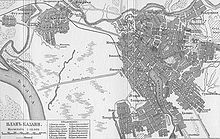
Kazan city map from the 19th century, Russian edition
In 1708, the Tsardom of Kazan was abolished, and Kazan became the seat of Kazan Governorate. After Peter the Great's visit, the city became a center of shipbuilding for the Caspian fleet. The major Russian poet Gavrila Derzhavin was born in Kazan in 1743, the son of a poor country squire of Tatar ancestry though himself having a thoroughly Russian identity.
Before the building of modern dams, low-lying areas were regularly flooded in April and May. Kazan suffered major fires in 1595, 1672, 1694, 1742, 1749, 1757 1744, 1815 and 1842.
Kazan was largely destroyed in 1774 as a result of the Pugachev revolt (1774–1776), an uprising by border troops and peasants led by the Don Cossack ataman (Captain) Yemelyan Pugachev, but the city, formerly largely of timber construction, was soon afterwards rebuilt, using stone and according to a grid pattern plan, during the reign of Catherine the Great. Catherine also decreed that mosques could again be built in Kazan, the first being Marjani Mosque.
At the beginning of the 19th century Kazan State University and printing press were founded by Alexander I. It became an important center for Oriental Studies in Russia. The Qur'an was first printed in Kazan in 1801. Kazan became an industrial center and peasants migrated there to join its industrial workforce. In 1875, a horse tramway appeared; 1899 saw the installation of a tramway. After the Russian Revolution of 1905, Tatars were allowed to revive Kazan as a Tatar cultural center. The first Tatar theater and the first Tatar newspaper appeared.
Soviet period
In 1917, Kazan became one of the revolution centers. In 1918, Kazan was the capital of the Idel-Ural State, which was suppressed by the Bolshevist government. In the Kazan Operation of August 1918, it was briefly occupied by Czechoslovak Legions. In 1920, Kazan became the center of Tatar Autonomous Soviet Socialist Republic. In the 1920s and 1930s, most of the city's mosques and churches were destroyed, as occurred elsewhere in the USSR.[citation needed]
After the Treaty of Rapallo (1922) until 1933, the German and the Russian army operated together the Kama tank school in Kazan.
During World War II, many industrial plants and factories to the west were relocated in Kazan, making the city a center of the military industry, producing tanks and planes. After the war Kazan consolidated as an industrial and scientific center. In 1979, the city's population reached one million.
Modern period

Dmitry Medvedev visits Kazan.

Bauman street
In the late 1980s and in the 1990s, after the dissolution of the Soviet Union, Kazan again became the center of Tatar culture and identity, and separatist tendencies intensified. With the return of capitalism, Kazan became one of the most important centers of the Russian Federation. The city went from 10th to 8th position in population ranking of Russian cities. In the early 2000s, the city earned the right to host both the 2013 Summer Universiade and 2018 FIFA World Cup.
Millennium of Kazan

Millennium Bridge
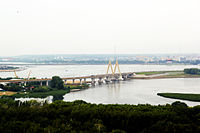
Millennium Bridge
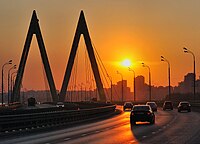
Millennium Bridge
Since 2000, the city has been undergoing a total renovation. The historical center—including the Kremlin—has been rebuilt, however a large number of the city's historical districts were completely demolished in the renovation. Kazan celebrated its millennium in 2005, after a city-organized historical commission settled on 1005 as the official year of the city's founding.[2] During the millennium celebrations, one of the largest mosque in Russia, Qolsharif, was dedicated in the Kazan Kremlin, the holiest copy of Our Lady of Kazan was returned to the city, the Millennium Bridge was inaugurated that year,[23] and the Kazan Metro began operation. The government of the Russian Federation released the Medal "In Commemoration of the 1000th Anniversary of Kazan".
In 2010, for the preparations to the 2013 Universiade, Kazan began even more renovation by modernizing its airport, fixing the streets, enhancing public transport, and adopting Russian, English, and Tatar languages in all transportation, large stores, and shopping centers.
Heraldry
The historical symbol of Kazan is the mythical dragon-like creature Zilant, often mentioned in legends. For example, when numerous snakes and reptiles severely hampered the development of the city, the hunters went in search of the King of snakes and defeated him, according to another version, the residents of the city bought off the giant snake with gold, after which all the snakes left the city. Another legend says that the giant dragon-like serpent always guarded the Khan's treasures, and that it still protects the hidden wealth before the capture of the city in the secret caves. Historically, it is true that snakes were once numerous in the Kazan region, but then their number has decreased dramatically. The first official coat of arms of Kazan was approved on 18 October 1781 and was described as "black snake under the crown of gold, Kazan, red wings, white field". In 1926, the country introduced a ban on such heraldry. In the 1980s, we again started talking about the coat of arms of Kazan, and in the 1990s Kazan Zilant in various styles began to appear in print media. Modern graphics of the emblem and flag appeared in 2005—in a silver field on the green earth a black dragon with red wings and tongue, with gold paws, claws and eyes, topped with a gold crown. The shield is crowned with a Kazan cap. According to the traditions of heraldry, the dragon symbolizes power, wisdom and invincibility, the earth—life and wealth, the crown-development, and the cap above the shield-the capital of the city.[24][25]
Administrative and municipal status
Kazan is the capital of the republic.[citation needed] Within the framework of administrative divisions, it is incorporated as the city of republic significance of Kazan—an administrative unit with the status equal to that of the districts.[1] As a municipal division, the city of republic significance of Kazan is incorporated as Kazan Urban Okrug.[9]
City divisions

City districts of Kazan
Kazan is divided into seven districts:
| No. | District | Population[6] | Area (km²)[citation needed] |
|---|---|---|---|
| 1 | Aviastroitelny | 111,405 | 38.91 |
| 2 | Vakhitovsky | 86,202 | 25.82 |
| 3 | Kirovsky | 109,125 | 108.79 |
| 4 | Moskovsky | 130,537 | 38.81 |
| 5 | Novo-Savinovsky | 202,997 | 20.66 |
| 6 | Privolzhsky | 227,755 | 115.77 |
| 7 | Sovetsky | 275,514 | 167.00 |
Economy

Kazanorgsintez chemical plant

Corston-Kazan with local World trade center
@media all and (max-width:720px){.mw-parser-output .tmulti>.thumbinner{width:100%!important;max-width:none!important}.mw-parser-output .tmulti .tsingle{float:none!important;max-width:none!important;width:100%!important;text-align:center}}




Kazan is one of the largest industrial and financial centers of Russia, and a leading city of the Volga economic region in construction and accumulated investment.[26] City's Gross Regional Product had reached 380 billion rubles in 2011.[27]
Total banking capital of Kazan banks is third in Russia.[citation needed] The main industries of the city are: mechanical engineering, chemical, petrochemical, light and food industries. An innovative economy is represented by the largest IT-park in Russia which is one of the largest of its kind among Eastern Europe science parks.[28][29] Kazan ranks 174th (highest in Russia) in Mercer’s Worldwide Quality of Living Survey.[30]
Investments
In 2011, city organisations and businesses attracted more than 87 billion rubles for economy and social sphere development. This was 44% more than in 2010. In 2014, businesses attracted 86 billion rubles. Most of them have been implemented in the real economy sector.
Because of the unstable economic situation within the country, there was a decrease of investment rates in 2015 and—according to the statistics of the first part of the year—it composed 51684.2 million rubles.
There are head offices of six companies that are in the top 500 in terms of revenues in Russia. The total area of city business centres is 330 thousand square metres.
Innovative economy in Kazan is represented by the biggest IT-park in Russia and also the biggest technical park in Europe. The only online platform for governmental trade except the Moscow one is operated in Kazan. During the post-Soviet period Kazan was the leader in terms of house construction in the Volga region, and now it holds the position and implements the Republican program of liquidation of dilapidated housing which was unique for Russia.
According to Forbes, Kazan was ranked 15th among the "Best cities for business in Russia" of 2010.[31] In 2012, Kazan ranked 6th in the quality of city environment rating, which was made by the Russian Federation Ministry of Regional Development, Russian Alliance of Engineers, Federal Construction Agency, Federal Service of Supervision of Consumer Protection and Welfare and Moscow Federal University.[32]
Transportation
Cycling
On 1 July 2013, the Veli'k bicycle sharing system was launched in Kazan. The system includes seven self-service bicycle docking stations, and a total of 100 bikes, distributed throughout the centre of Kazan, near the most popular city destinations. The service is open to everyone from 16 years of age. To access the service, riders have to complete a simple sign-up procedure at www.Veli-k.ru, and buy a subscription for a suitable period of time. The first 30 minutes of every journey is free of charge. After the first half-hour, a service charge applies.
Public transit
Travel cards that work within the metropolitan area reduce the cost of travel to 15 rub on trolley buses and buses, and offer considerable discounts on the metro line. These travel cards can be purchased from the post office.
Bus
The Kazan Bus system was totally renovated in 2007. 91 routes have an aggregate length of 1,981 km (1,231 mi). All 1,444 buses are colored red, as in London. A single trip costs 25 rub. Unlike in most Western cities, public bus routes are not municipal, but are operated by private companies. Half of the buses are imported, produced by Golden Dragon, Higer, MAZ, Yutong, and Hyundai. Other buses are mostly Russian made NefAZ.
Tram
The Kazan Tram system was founded in 1899. Six routes use 187 km (116.20 mi) of tracks and 197 tramcars. All trams are dark red.[33] A single trip costs 25 rub. Rolling stock: LM-99, 71-608, 71-605.
Trolleybus
The Kazan trolleybus electric bus system was founded in 1948. 355 km (220.59 mi) of lines are used for 14 routes. All trolleybuses are green[34] Single trip costs 25 rub. Vehicles: ZIU-682, Trolza-5275-05 "Optima", VMZ-5298.01-50 "Avangard".
Metro
A single-line Kazan Metro (running north to south-east), opened on 27 August 2005, the first and only metro system built in a post-soviet state after the collapse of the USSR. As of 2018, the Kazan Metro now has ten stations, and crosses the Kazanka River.
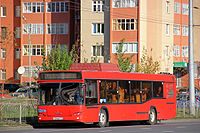
MAZ-103 low-entry bus

Trolza-5275 low-entry trolleybus

AKSM 843 tram

Metro train
Railways

Main railway station
Kazan is connected with Moscow, Ulyanovsk, Yoshkar-Ola and Yekaterinburg by train.
The main railway station Kazan–Passazhirskaya is located in the city centre and includes a main building (built in 1896), a commuter trains terminal, a ticket office building and some other technical buildings. The station serves 36 intercity trains and more than eight million passengers per annum.[35] The second terminus called "Kazan-2" is situated in the northern part of the city. Kazan also has 19 platforms for commuter trains.
Waterways

Bolaq channel
This station serves intercity ships and commuter boats. Pneumocushion boats are used in winter. Daily passenger turnover reaches six thousand.
Highways
There are federal highway connections to Moscow and Ufa (E-22), Orenburg (R-239), Ul'yanovsk (R-241) and Igra (R-242). There are also the R-175 federal highway and "Northern Europe – Western China" (in construction) route near the city.
There are five bridges across the Kazanka (Qazansu) river in the city, and one bridge connecting Kazan with the opposite bank of the Volga.
Intercity buses
There are two bus stations in Kazan—Central and Southern. Bus routes connect Kazan with all districts of Tatarstan, Samara, Ufa, Tolyatti, Orenburg, Ulyanovsk, Cheboksary, Sterlitamak, Buzuluk, Baki, and Aktobe. It is planned to build new stations in the East, West and North districts instead of Central for relieving city centre.
Kazan International Airport

Kazan International Airport
Kazan International Airport is located 26 kilometers (16 mi) from the city center. It is a hub for Tatarstan Airlines and Kazan Air Enterprise and hosts eleven air companies. The airport is connected with the city by bus route #97 and by a suburban train line.
There is also the Kazan Borisoglebskoye airfield, home to Kazan Aircraft Production Association, a major aircraft factory, famous in the past as "Aircraft Plant 22" ("22nd Zavod").
Adjacent to it lies a huge aircraft engines plant ("16th Zavod"). It produces versions of Tupolev 204 and 214 aircraft. In the past an Ilyushin-62, four-engine Russian mainliner, Tupolev-160 "Black Jack" supersonic strategic bomber and Tu-22M tactic bomber were also produced here. Both these plants and adjacent workers' housing make a whole city district known as "Aviastroitelny" ("Aircraft Builders").
Demographics
Population

Population of Kazan since 1800
Population: 1,143,535 (2010 Census);[6]1,105,289 (2002 Census);[36]1,094,378 (1989 Census).[37]Kazan metropolitan area's population is 1.65 million.
| Year | Population |
|---|---|
| 1550 | 5,000 |
| 1557 | 7,000 |
| 1800 | 40,000 |
| 1830 | 43,900 |
| 1839 | 51,600 |
| 1859 | 60,600 |
| 1862 | 63,100 |
| 1883 | 140,000 |
| 1897 | 130,000 |
| 1917 | 206,600 |
| 1926 | 179,000 |
| 1939 | 398,000 |
| 1959 | 667,000 |
| 1979 | 989,000 |
| 1989 | 1,094,378 (census) |
| 1997 | 1,076,000 |
| 2000 | 1,089,500 |
| 2002 | 1,105,289 (census) |
| 2008 | 1,120,200 |
| 2009 | 1,130,717 |
| 2010 | 1,143,535 (census) |
| 2016 | 1,216,965 |
Ethnicity

Young women in the street, outside Kazan University
The city's population consists mostly of ethnic Tatars (48.3%) and ethnic Russians (47.9%). The other ethnicities are Chuvash, Ukrainians, Azerbaijanis, Vietnamese,[38][39][40] and Jews.[41]
Religion
Predominant faiths of Kazan city are Sunni Islam and Orthodox Christianity, with Roman Catholicism, Protestantism, Judaism and the Bahá'í Faith also represented.
Languages
The Tatar language is widely spoken in the city mainly by Tatars. Russian language is also widely spoken, mainly by Russians.
Geography
Satellite view

Night aerial view of radial Kazan
Climate
Kazan has a humid continental climate (Köppen: Dfb) with long, cold winters (colder than Moscow), and warm, often dry summers. As a result of its far inland position, summers are extremely warm for its latitude and winters are quite cold compared to areas further west in Europe.[citation needed]
The warmest month is July with daily mean temperature near 20.2 °C (68.4 °F), and the coldest month is January, with a daily mean of −10.4 °C (13.3 °F).[citation needed]
The city set its two hottest days on record during the 2010 Northern Hemisphere summer heat waves. Temperatures reached +39 °C (102 °F) in the hottest days during that time.[citation needed]
| Climate data for Kazan | |||||||||||||
|---|---|---|---|---|---|---|---|---|---|---|---|---|---|
| Month | Jan | Feb | Mar | Apr | May | Jun | Jul | Aug | Sep | Oct | Nov | Dec | Year |
| Record high °C (°F) | 4.5 (40.1) | 5.2 (41.4) | 14.0 (57.2) | 29.5 (85.1) | 33.5 (92.3) | 37.5 (99.5) | 38.9 (102) | 39.0 (102.2) | 32.3 (90.1) | 23.4 (74.1) | 15.0 (59) | 6.1 (43) | 39.0 (102.2) |
| Average high °C (°F) | −7.2 (19) | −6.7 (19.9) | −0.2 (31.6) | 10.2 (50.4) | 19.0 (66.2) | 23.6 (74.5) | 25.5 (77.9) | 22.9 (73.2) | 16.3 (61.3) | 8.1 (46.6) | −1.0 (30.2) | −5.8 (21.6) | 8.7 (47.7) |
| Daily mean °C (°F) | −10.4 (13.3) | −10.1 (13.8) | −3.9 (25) | 5.5 (41.9) | 13.3 (55.9) | 18.1 (64.6) | 20.2 (68.4) | 17.6 (63.7) | 11.7 (53.1) | 4.8 (40.6) | −3.4 (25.9) | −8.6 (16.5) | 4.6 (40.3) |
| Average low °C (°F) | −13.5 (7.7) | −13.3 (8.1) | −7.2 (19) | 1.7 (35.1) | 8.3 (46.9) | 13.4 (56.1) | 15.5 (59.9) | 13.3 (55.9) | 8.2 (46.8) | 2.2 (36) | −5.6 (21.9) | −11.4 (11.5) | 1.0 (33.8) |
| Record low °C (°F) | −46.8 (−52.2) | −39.9 (−39.8) | −31.7 (−25.1) | −25.6 (−14.1) | −6.5 (20.3) | −1.4 (29.5) | 2.6 (36.7) | 1.6 (34.9) | −5.4 (22.3) | −23.4 (−10.1) | −36.6 (−33.9) | −43.9 (−47) | −46.8 (−52.2) |
| Average precipitation mm (inches) | 41 (1.6) | 34 (1.3) | 33 (1.3) | 30 (1.2) | 41 (1.6) | 63 (2.5) | 67 (2.6) | 59 (2.3) | 52 (2) | 53 (2.1) | 46 (1.8) | 43 (1.7) | 562 (22.1) |
| Average rainy days | 3 | 2 | 4 | 11 | 15 | 18 | 16 | 16 | 18 | 17 | 10 | 5 | 135 |
| Average snowy days | 26 | 22 | 16 | 6 | 1 | 0 | 0 | 0 | 1 | 7 | 20 | 24 | 123 |
| Average relative humidity (%) | 84 | 80 | 76 | 67 | 58 | 65 | 68 | 70 | 75 | 80 | 85 | 84 | 74 |
| Mean monthly sunshine hours | 49 | 89 | 150 | 205 | 282 | 293 | 291 | 254 | 160 | 84 | 41 | 33 | 1,931 |
| Source #1: Pogoda.ru.net[42] | |||||||||||||
| Source #2: NOAA (sun, 1961–1990)[43] | |||||||||||||
Central Kazan

Qolşärif Mosque grand mosque

Belltower of Epiphany Church
Kremlin
The city has a citadel (Russian: кремль, tr. kreml', or sometimes Tatar: kirman), which was declared a World Heritage Site in 2000. Major monuments in the Kremlin are the five-domed, six-columned Annunciation Cathedral (1561–62) and the mysterious, formerly leaning Söyembikä Tower, named after the last queen of Kazan and regarded as the city's most conspicuous landmark.
Also of interest are the towers and walls, erected in the 16th and 17th centuries but later reconstructed; the Qol-Şarif Mosque, which has been rebuilt inside the citadel; remains of the Saviour Monastery (a 16th-century cathedral demolished by the Bolsheviks) with the Spasskaya Tower; and the Governor's House (1843–53), designed by Konstantin Thon, now the Palace of the President of Tatarstan.
Next door, the ornate baroque Sts-Peter-and-Paul's Cathedral on Qawi Nacmi Street and Marcani Mosque on Qayum Nasiri Street date back to the 18th century.
Towers
The Spasskaya Tower was built in two floors by 16th century Pskov architects Ivan Shiryai and Postnik Yakovlev. From the inside, the northern side of the fortress to the Spasskaya Tower adjoined the gate to Spasskaya Church, which has now merged with the tower. The typical Pskovian architectural elements of the facade face the main street of the Kremlin. At the end of the 17th century, instead of three tiers, the tower was built with two brick eight-sided tiers with a brick roof, getting its present, familiar appearance. Until 1917, the tower was crowned with the double-headed coat of arms of the Russian state. In the 18th century, a ringing clock was installed in the upper tier, and even earlier a large bell was moved from a small belfry (now lost, located on the castle wall on the left side of the tower). Until the middle of the 19th century, there was a moat with a stone bridge in front of the tower.
The South-Western Tower was built simultaneously with the Spasskaya tower by Pskov masters and is a classic example of the Pskov style of defensive structures.
The name of the Transfiguration Tower comes from the Transfiguration Monastery of the Savior, which was fenced from the north-west. The tower was also built by Pskov architects Postnik and Barma, but it was significantly rebuilt later, as it has strong traces of the architectural influence of the Moscow defensive architecture. The territory from the Transfiguration Tower to the Spasskaya pass was added to the old Khan's fortress by Pskov masters.
There are unnamed round brick towers, presumably built by Moscow architects in the 17th century.
The Tainitskaya Tower was built in its present form in the 1550s by Postnik Yakovlev. It was named after a secret source from which it was possible to take water during a siege. The entrance to the tower is in the form of a "knee", which increased the defense of the Kremlin. It replaced a tower from the time of the khanate, Nur Ali (in Russian transcription Muraleeva). The 22-year-old Tsar Ivan the Terrible entered the conquered city through the Nur Ali tower.
The North-Eastern Round Tower was demolished after the Pugachev's assault.
The Consistor Tower was built in brick by Moscow architects in the 17th century, its name was given in the 18th century from the Spiritual Consistory located near the tower in the Kremlin. Near the tower, archaeological excavations revealed the so-called Tezitsky (Arabic for "merchant") Moat, which went from the Consistor Tower to the Transfiguration. Archaeologist N. Kalinin and a number of scientists believed that the moat was the southern border of the Khan's fortress.
The Southeast Round Tower is an example of Pskov architecture of the 16th century.
Bistä, or Posad
Central Kazan is divided into two districts by the Bolaq canal and Lake Qaban. The first district (Qazan Bistäse or Kazanskiy Posad), historically Russian, is situated on the hill, the second (İske Tatar Bistäse or Staro-Tatarskaya Sloboda), historically Tatar, is situated between the Bolaq and the Volga. Mosques, such as Nurullah, Soltan, Bornay, Apanay, Äcem, Märcani, İske Taş, Zäñgär are in the Tatar district. Churches, such as Blagoveschenskaya, Varvarinskaya, Nikol'skaya, Tikhvinskaya, are mostly in the Russian part of the city. The main city-centre streets are Bauman, Kremlyovskaya, Dzerzhinsky, Tuqay, Puşkin, Butlerov, Gorkiy, Karl Marx and Märcani.
An old legend says that in 1552, before the Russian invasion, wealthy Tatars (baylar) hid gold and silver in Lake Qaban.
Wooden Kazan
In the beginning of the 1900s most of Central Kazan was covered by wooden buildings, usually consisting of two floors. There was a historical environment of Kazan citizens, but not the best place to live in. During the Republican program "The liquidation of ramshackle apartments" most of them (unlike other Russian cities), especially in Central Kazan, where the land is not cheap, were destroyed and their population was moved to new areas at the suburb of the city (Azino, Azino-2, Quartal 39). Nearly 100,000 citizens resettled by this programme.
Other major buildings
Another significant building in central Kazan is the former "Smolentzev and Shmelev" tea house and hotel, now the Shalyapin Palace Hotel. It is located at 7/80 Universitetskaya Street, at the corner of Universitetskaya and Bauman. A major landmark of late-19th and early-20th century commercial architecture, it consists of two portions. The original portion, built for a merchant named Usmanov in the 1860s, was bought by the inter-related families of Efim Smolentzev and Pavel and Nikolai Shmelev in 1899.[44] They operated a store selling, among other things, tea. In 1910, the Smolentevs and Shmelevs constructed another portion, designed by architect Vasili Trifonov, and operated a hotel there.[45] After the Russian Revolution, the building eventually became the Hotel Soviet and after 2000 it was heavily renovated to reopen as the Shalyapin Palace Hotel.
The National Museum of Tatarstan

Palace of agriculture
Pyramid concert hall
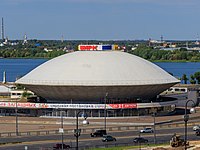
Kazan circus
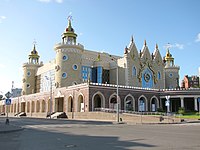
Children's palace
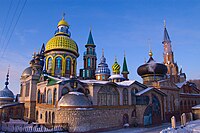
Temple of All Religions
Cityscape
Education and science
Primary and secondary education
Primary and secondary education system of Kazan includes:
- 282 nurseries, most of which are municipal
- 178 schools, 2 of which are private
- 28 vocational technical schools
- 15 colleges
- 10 special colleges
There are also 49 music schools, 43 sports school, and 10 fine-arts schools, including the Kazan Art School founded in 1895.
Higher education
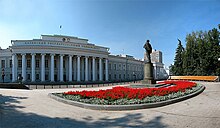
Kazan Federal University
There are 44 institutes of higher education in Kazan, including 19 branches of universities from other cities. More than 140,000 students are educated in the city.
Kazan Federal University (founded in 1804) is third oldest university in Russia after Saint Petersburg State University (1724) and Moscow State University (1755). In 2009 KFU got Federal status as main university of Volga Region.
Some other prominent universities are:
Kazan State Technical University – founded in 1932. In 2009 it got status of National university
Kazan State Medical University – founded in 1814 as a department within Kazan State University
Kazan State Technological University – founded in 1919 on the base of pre-existing vocational school
Kazan State Conservatory – founded in 1945
Volga Region State Academy of Physical Culture, Sport and Tourism – founded in July 2010 in the framework of the XXVII World Summer Universiade Legacy. The branch, located in Naberezhnye Chelny, will proceed functioning.
Science

Main building of Tatarstan Academy of Sciences
Kazan is a major scientific centre in Russia. Kazan formed a big number of scientific areas and schools (mathematical, chemical, medical, linguistic, geological, geobotanical, etc.). Scientific discoveries are a subject of special pride, including: the creation of non-Euclidean geometry (Nikolai Lobachevsky), the discovery of the chemical element ruthenium (Karl Ernst Claus), the theory about the structure of organic compounds (Aleksandr Butlerov), the discovery of the electron paramagnetic resonance (Yevgeny Zavoisky) and acoustic paramagnetic resonance (Altshuler) and many others. The city hosts:
Kazan Science Centre of Russian Academy of Sciences, since 1945. It includes 5 academic institutions.
Tatarstan Academy of Sciences, since 1991. It includes 7 local departments with 13 academic institutions (also, 21 organisations are under the guidance of TAS) and one branch in Ulyanovsk.[46]
Public health
1814 year is considered to be an official year of the beginning of scientific medicine in Kazan. Exactly at that time University Hospital was open. In 1930 Faculty of Medicine is separated from the Kazan Federal University and holds a lot of specialized hospitals under its patronage. Nowadays Kazan becomes the largest public health center in Russia. 120 medical organisations are operated in the city. Kazan Interregional clinical-diagnostic center is the largest in Volga region in cardiovascular and neurological diseases. The largest hospital in Kazan is Republican Clinical Hospital.
Government and administration

Kazan town hall (before 1917 - the Hall of Nobility)

Cabinet of Ministers

Presidential Palace
Mayor
City Duma
Kazan City Duma is a representative body of the city, elected every four years and holds its sessions in Kazan City Hall.
Executive committee
Executive committee is a municipal body of the executive organs .[clarification needed] The committee's head is Denis Kalinkin.[47]
Government of the Republic of Tatarstan
Kazan hosts Tatarstan President's residence and administration (in Kremlin), Tatarstan's Cabinet of Ministers and Council of State (on Freedom square).
Communication
Agency works 84 post offices belonging to the branch of "Russian Post", UFPS "Tatarstan pochtasy". The official opening of the Kazan city telephone network took place on 27 (15) November 1888. At the moment, there are four operators of wired telephone in Kazan. The total capacity of the telephone network in Kazan is about 456,000 numbers. Services of IP-telephony operators in addition to the basic wired connection is also supported by the five companies.[48] The city has six mobile operators (Beeline, MegaFon, MTS, Tele2 Russia, Letai, Yota, and also operates virtual mobile operator "Mobile public communication"). By the number of Internet users—428 thousand people—Kazan takes the 4th place in Russia. According to the General Director of Google Russia Vladimir Dolgov, Kazan is the largest center of information technology development, the level of Internet penetration is 75%, which is a record figure for Russia. Access to the World Wide Web in Kazan is provided by 15 operators.[49] The most popular forms of Internet access are cable networks and ADSL. Previously popular Dial-up has almost lost its position, at the same time actively developing wireless technology Wi-Fi and Wi-Max. Scartel launched the first LTE network in Russia.[50]
On 30 August 2012 in Kazan, IT Park was held a launch ceremonyfor the fourth generation network (4G, LTE). LTE network in Kazan was launched by three operators - Scartel LLC (Yota trademark), MegaFon OJSC and MTS OJSC. On 27 June 2014, the LTE network of mobile operator Fly was launched.
Sports

The Kazan Arena hosted the 2018 FIFA World Cup games

"Basket-hall"

Kazan rowing center
Kazan now is one of the most developed cities in Russia in terms of sport. The city has hosted two Bandy World Championships, in 2005 and 2011, the World Summer Universiade 2013, the World Championship in fencing in 2014, the Aquatics Championship FINA 2015, 2017 FIFA Confederations Cup and other international competitions of various levels. In the future the city will hold the 2018 FIFA World Cup.
The city of Kazan is a leader in terms of winnings in various sports including its most popular sports teams.
Men's teams:
| Club | Sport | Founded | Current league | League rank | Stadium |
|---|---|---|---|---|---|
Rubin Kazan | Football | 1958 | Russian Premier League | 1st | Kazan Arena |
Ak Bars Kazan | Ice Hockey | 1956 | Kontinental Hockey League | 1st | Tatneft Arena |
| Bars Kazan | Ice Hockey | 2009 | Minor Hockey League | Jr. 1st | Tatneft Arena |
| Irbis Kazan | Ice Hockey | 2011 | Minor Hockey League Division B | Jr. 2nd | Tatneft Arena |
Dynamo-Kazan | Bandy | 1958 | Bandy Super League | 1st | Raketa Stadium |
UNICS Kazan | Basketball | 1991 | Professional Basketball League | 1st | Basket-Hall Arena |
Zenit Kazan | Volleyball | 2000 | Volleyball Super League | 1st | Kazan Volleyball Centre |
Sintez Kazan | Water Polo | 1974 | Water Polo Championship | 1st | Orgsintez |
Notable athletes
Aliya Mustafina, athletics champion
Alexander Burmistrov, hockey player
Viktor Kolotov, association football player
Ruslan Nigmatullin, association football player
Denis Arkhipov, hockey player
Svetlana Demina, sport shooter
Marat Safin, tennis player
Dinara Safina, tennis player
Alexander Fadeev, figure skater
Vasily Mosin, sport shooter
Infrastructure
Kazan Arena – stadium with capacity 45,000, home ground for FC Rubin
Central stadium – Olympic stadium, capacity 30,133. Ex-home ground for FC Rubin.
TatNeft Arena – indoor sporting arena, capacity 10,000. Home to HSC Aq Bars
Basket-Hall – indoor sporting arena, capacity 7,000 (large hall) and 1,500 (small hall). Home to BC UNICS
Kazan Volleyball Centre, capacity 4,600. Home to VC Zenit and WVC Dynamo-Kazan
Raketa and Trudovye Rezervy ice stadiums
Important events
- 2019 WorldSkills Championship
- 2018 FIFA World Cup
- 2017 and 2018 Red Bull Air Race World Championship
- Kazan is the host city for the 2013 Summer Universiade, 2015 World Aquatics Championships, 2017 FIFA Confederations Cup and 2018 FIFA World Cup.
- 2016 – 28th International Olympiad in Informatics
- 2016 European Judo Championships
- 2014 European Badminton Championships
- 2011 European Weightlifting Championships
2005 and 2011 Bandy World Championship
- 2010 finswimming European championship
International relations
Kazan is actively engaged in international activities. The city has foreign diplomatic, trade and cultural representations, the Kazan Kremlin and the Institute of culture of peace are under the auspices of UNESCO, the city participates in partner movements, is a member of the world organizations of cities. The summit of the CIS heads, the Summit of the world security services and other important forums, conferences and events of the world level were held in Kazan. The head of China, the us Secretary of state, about three dozen presidents and Prime Ministers of foreign States paid visits to the capital of the Republic, as to few other cities of the country. Renovated in 2005, the international airport provides flights to dozens of cities in different countries, including the largest Airliners (class Boeing 747), and is gradually being rebuilt into a potential hub for the Universiade 2013 and the World Cup 2018; international rail links from the city.
Branch offices of embassies
 Branch Office of the Embassy of Belarus[51]
Branch Office of the Embassy of Belarus[51]
Consulates
Four consulates general are found in Kazan.[52]
 Consulate-General of Iran
Consulate-General of Iran
 Consulate-General of Turkey
Consulate-General of Turkey
 Consulate-General of Hungary
Consulate-General of Hungary
 Consulate-General of Kazakhstan
Consulate-General of Kazakhstan
Visa centers
 Italian Visa Center in Kazan.[53]
Italian Visa Center in Kazan.[53]
 Joint Visa Application Center of European Union for:
Joint Visa Application Center of European Union for:
 Bulgaria
Bulgaria
 Czech Republic
Czech Republic
 Denmark
Denmark
 Finland[54]
Finland[54]
 Greece
Greece
 Iceland
Iceland
 Malta
Malta
 Netherlands
Netherlands
 Spain
Spain
Twin towns and sister cities
Kazan is twinned with:[55]
Al Qalyubiyah (Egypt), since 2001
Al Minufiyah (Egypt), since 1997
Antalya (Turkey), since 2003
Astana (Kazakhstan), since 2004
Braunschweig (Germany), since 1988[56]
College Station, Texas, United States, since 1990
Donetsk (Ukraine), since 2002
Eskişehir (Turkey), since 1997
Hangzhou (China), since 2002
Istanbul (Turkey), since 2002
Tabriz (Iran), since 2009
Harare (Zimbabwe), since 2011
Shenzhen (China), since 2012
Guangzhou (China), since 2012
Ankara (Turkey), since 2013
Kazan has also partner relations with the following cities and regions:
Almaty (Kazakhstan), since 1996
Arkhangelsk (Russia), since 1999
Astrakhan (Russia), since 1997
Baku (Azerbaijan), since 2003
Bishkek (Kyrgyzstan), since 1998
Chelyabinsk (Russia), since 2002
Evpatoria (Ukraine), since 1998
Ivanovo (Russia), since 1997
Jūrmala (Latvia), since 2002
Kabul (Afghanistan), since 2005
Krasnoyarsk (Russia), since 2001
Nizhny Novgorod (Russia), since 1997
Orenburg (Russia), since 2001
Samara (Russia), since 1998
Saratov (Russia), since 1999
Shumen Province (Bulgaria), since 2003
Tashkent (Uzbekistan), since 1998
Ufa (Russia), since 1999
Ulan-Ude (Russia), since 2003
Ulyanovsk (Russia), since 1998
Urbino (Italy), since 2001
Volgograd (Russia), since 2005
Yaroslavl (Russia), since 2003
Yoshkar-Ola (Russia), since 2002
Oryol (Russia), since 2010
Tlemcen (Algeria), since 2011
Verona (Italy), since 2011
Grozny (Russia), since 2012
Tyumen (Russia), since 2013
Gwangju (Korea), since 2013
Chengdu (China), since 2015
International organizations membership
- Organization of World Heritage Cities
- United Cities and Local Governments
- Twin Cities International Association
- Historic Cities International Association
- General Conference of Mayors for Peace
- Organisation of Islamic Capitals and Cities (observer)
- Metropolis
- International Assembly of capitals and large cities of CIS
Other organizations
- Alliance Française
American Corner[57]
Notable people
Rashid Nezhmetdinov, International Master and five-time winner of the Russian Chess Championship
Dayana Kirillova, singer who represented Russia at the Junior Eurovision Song Contest in 2013
Sofya Gulyak, pianist, only female winner of the Leeds Piano Competition, in 2009
Venera Gimadieva, operatic soprano who has performed leading roles in major European opera houses
See also
- Kizichesky Monastery
- Russian Islamic University
- Saints Peter and Paul Cathedral (Kazan)
References
Notes
^ abcde Order #01-02/9
^ ab Шаймиев, Минтимер Шарипович; Исхаков, Камиль; Хәсәнов, Мансур Х (10 September 1999). "Выступления Президента РТ М. Шаймиева, мэра г.Казани К.Исхакова и президента АН РТ, академика М.Хасанова на торжественном собрании по случаю установления даты основания г.Казани". Гасырлар авазы/Эхо веков (in Russian) (3/4). Archived from the original on 2 October 2011. Retrieved 17 July 2011..mw-parser-output cite.citation{font-style:inherit}.mw-parser-output q{quotes:"""""""'""'"}.mw-parser-output code.cs1-code{color:inherit;background:inherit;border:inherit;padding:inherit}.mw-parser-output .cs1-lock-free a{background:url("//upload.wikimedia.org/wikipedia/commons/thumb/6/65/Lock-green.svg/9px-Lock-green.svg.png")no-repeat;background-position:right .1em center}.mw-parser-output .cs1-lock-limited a,.mw-parser-output .cs1-lock-registration a{background:url("//upload.wikimedia.org/wikipedia/commons/thumb/d/d6/Lock-gray-alt-2.svg/9px-Lock-gray-alt-2.svg.png")no-repeat;background-position:right .1em center}.mw-parser-output .cs1-lock-subscription a{background:url("//upload.wikimedia.org/wikipedia/commons/thumb/a/aa/Lock-red-alt-2.svg/9px-Lock-red-alt-2.svg.png")no-repeat;background-position:right .1em center}.mw-parser-output .cs1-subscription,.mw-parser-output .cs1-registration{color:#555}.mw-parser-output .cs1-subscription span,.mw-parser-output .cs1-registration span{border-bottom:1px dotted;cursor:help}.mw-parser-output .cs1-hidden-error{display:none;font-size:100%}.mw-parser-output .cs1-visible-error{font-size:100%}.mw-parser-output .cs1-subscription,.mw-parser-output .cs1-registration,.mw-parser-output .cs1-format{font-size:95%}.mw-parser-output .cs1-kern-left,.mw-parser-output .cs1-kern-wl-left{padding-left:0.2em}.mw-parser-output .cs1-kern-right,.mw-parser-output .cs1-kern-wl-right{padding-right:0.2em}
^ Official website of Kazan. Kazan City Duma Archived 4 March 2012 at the Wayback Machine. (in Russian)
^ ab Official website of the Mayor of Kazan Archived 3 September 2011 at the Wayback Machine. (in Russian)
^ площадь собственно города, Федеральная служба государственной статистики Archived 15 November 2013 at the Wayback Machine.
^ abc Russian Federal State Statistics Service (2011). "Всероссийская перепись населения 2010 года. Том 1" [2010 All-Russian Population Census, vol. 1]. Всероссийская перепись населения 2010 года [2010 All-Russia Population Census] (in Russian). Federal State Statistics Service.
^ ab Численность населения муниципальных образований Республики Татарстан (Population of the Republic of Tatarstan municipalities report, per 1st Jan. 2018) Archived 15 April 2016 at the Wayback Machine.
^ "Welcome to the Republic of Tatarstan". tatarstan.ru. Archived from the original on 16 September 2017. Retrieved 8 May 2018.
^ abc Law #46-ZRT
^ Правительство Российской Федерации. Федеральный закон №107-ФЗ от 3 июня 2011 г. «Об исчислении времени», в ред. Федерального закона №368-ФЗ от 11 октября 2018 г. «О внесении изменений в статью 5 Федерального закона "Об исчислении времени"». Вступил в силу по истечении шестидесяти дней после дня официального опубликования (6 августа 2011 г.). Опубликован: "Российская газета", №120, 6 июня 2011 г. (Government of the Russian Federation. Federal Law #107-FZ of June 31, 2011 On Calculating Time, as amended by the Federal Law #368-FZ of October 11, 2018 On Amending Article 5 of the Federal Law "On Calculating Time". Effective as of after sixty days following the day of the official publication.).
^ "Kazan Russia - a thousand-year Russian city travel guide". aboutkazan.com. Archived from the original on 28 August 2007. Retrieved 8 May 2018.
^ "Current Local Time in Kazan, Russia". www.timeanddate.com. Archived from the original on 9 February 2014. Retrieved 8 May 2018.
^ "ARCHIVED COPY". Archived from the original on 8 December 2009.CS1 maint: Archived copy as title (link)
^ "Kazan officially becomes Russia's Third Capital". Pravda. 3 April 2009. Archived from the original on 2 June 2013. Retrieved 26 March 2013.
^ Komsomolskaya Pravda: Kazan - sports capital of Russia 14.12.2009 Archived 24 July 2011 at the Wayback Machine.
^ "List of Best Tatars". Mytopdozen.com. Archived from the original on 3 April 2012. Retrieved 26 March 2013.
^ "2,1 млн. туристов посетили Казань в 2015 году" (in Russian). tatar-inform.ru. Archived from the original on 9 February 2016. Retrieved 9 February 2016.
^ "InTourist Kazan'". Legends about Kazan's foundation. Archived from the original on 27 October 2012. Retrieved 10 August 2012.
^ Ярмила Хаскова (1999). "Древнечешская монета из Казани" (in Russian) (1/2) (Гасырлар авазы / Эхо веков ed.).
^ "Кто сказал, что Казани - 1000 лет? Аргументы и факты о возрасте города" (in Russian). www.1000kzn.ru. Retrieved 18 November 2017.
^ abc ХУДЯКОВ. "Очерки по истории КАЗАНСКОГО ХАНСТВА" (in Russian).
Google translation: M.G. Khudyakov. "Essays on the history of KAZAN HOSPITAL".
^ Volga Tatars: A Profile in National Resilience. Hoover Press. 2017. ISBN 0817983937.
^ Putin joins Tatarstan festivities Archived 6 December 2012 at the Wayback Machine. BBC News 2005-08-26
^ История гербов города Казани и городов Казанской губернии
^ "Герб города Казань". Геральдика.ру (in Russian). geraldika.ru. Retrieved 18 November 2017.
^ "БГД". www.gks.ru (in Russian). Archived from the original on 29 January 2012. Retrieved 8 May 2018.
^ Катаргин, Дмитрий. "Казань побила рекорд по инвестициям". БИЗНЕС Online (in Russian). Retrieved 7 June 2018.
^ "В строительство IT-парка вложили 3 миллиарда". www.arendator.ru (in Russian). Archived from the original on 26 August 2013. Retrieved 8 May 2018.
^ Инновационный технопарк Идея Archived 2 February 2011 at the Wayback Machine.
^ NZ cities excel in quality of living - Mercer worldwide survey finds Archived 25 July 2011 at the Wayback Machine.
^ "30 лучших городов для бизнеса—2010". Forbes (in Russian). Archived from the original on 22 August 2011. Retrieved 9 February 2016.
^ Мысько, Сергей Афанасьев, Влас. "Казань оценили на "6 с плюсом"". БИЗНЕС Online (in Russian). Archived from the original on 10 August 2016. Retrieved 9 February 2016.
^ "Выступление А. К. Абдулхакова на аппаратном совещании 09.02.2009 «Об итогах работы городского пассажирского транспорта за 2008 год»". Сайт города Казани (in Russian). Archived from the original on 12 March 2010.
^ "В 2008 году в Казани всеми видами городского транспорта перевезено 319,9 млн. пассажиров". Tatar-inform (in Russian). 9 February 2009. Archived from the original on 13 December 2017. Retrieved 8 May 2018.
^ ГЖД в 2006 году больше всего пассажиров отправила со станции Горький-Московский Archived 24 August 2011 at the Wayback Machine.
^ Russian Federal State Statistics Service (21 May 2004). "Численность населения России, субъектов Российской Федерации в составе федеральных округов, районов, городских поселений, сельских населённых пунктов – районных центров и сельских населённых пунктов с населением 3 тысячи и более человек" [Population of Russia, Its Federal Districts, Federal Subjects, Districts, Urban Localities, Rural Localities—Administrative Centers, and Rural Localities with Population of Over 3,000] (XLS). Всероссийская перепись населения 2002 года [All-Russia Population Census of 2002] (in Russian).
^ "Всесоюзная перепись населения 1989 г. Численность наличного населения союзных и автономных республик, автономных областей и округов, краёв, областей, районов, городских поселений и сёл-райцентров" [All Union Population Census of 1989: Present Population of Union and Autonomous Republics, Autonomous Oblasts and Okrugs, Krais, Oblasts, Districts, Urban Settlements, and Villages Serving as District Administrative Centers]. Всесоюзная перепись населения 1989 года [All-Union Population Census of 1989] (in Russian). Институт демографии Национального исследовательского университета: Высшая школа экономики [Institute of Demography at the National Research University: Higher School of Economics]. 1989 – via Demoscope Weekly.
^ Massive fire breaks out in Kazan market Archived 25 December 2015 at the Wayback Machine.. Retrieved 2015-12-24.
^ Funds raised to support Vietnamese people in Kazan Archived 25 December 2015 at the Wayback Machine.. Retrieved 2015-12-24.
^ Donation to Vietnamese people in Kazan. Retrieved 2015-12-24.
^ (RUS) Новый облик Казани Archived 1 March 2007 at the Wayback Machine.
^ "Weather and Climate-The Climate of Kazan" (in Russian). Weather and Climate. Archived from the original on 22 December 2015. Retrieved 10 December 2015.
^ "Kazan Climate Normals 1961–1990". National Oceanic and Atmospheric Administration. Retrieved 10 December 2015.
^ "ИЗДАНИЯ ЦБС "Прогулки по городу"" (in Russian). Archived from the original on 11 May 2010. Retrieved 20 February 2008.
^ "До тысячелетия Казани осталось 36 дней. Гостиница "Совет"" (in Russian). Archived from the original on 2013-04-17. Retrieved 20 February 2008.
^ Структура АНРТ Archived 21 July 2011 at the Wayback Machine.
^ "ORIGINAL COPY". Archived from the original on 4 March 2016. Retrieved 13 October 2015.
^ "IP телефония (VoIP) (Казань)" (in Russian).
^ "Провайдеры - Подключить интернет вы можете, оставив заявку одному из провайдеров своего города в нашем каталоге" (in Russian). prov.nag.ru. Archived from the original on 1 October 2009. Retrieved 18 November 2017.
^ "Самый быстрый мобильный Интернет в мире запущен в Казани" (in Russian). www.tatar-inform.ru. 2010-08-30. Retrieved 18 November 2017.
^ "Посольство Беларуси в России – Отделения". www.embassybel.ru (in Russian). Archived from the original on 2 October 2017. Retrieved 8 May 2018.
^ Offices in Kazan Archived 24 September 2006 at the Wayback Machine.
^ Visa Management Service. Filiali Archived 5 August 2010 at the Wayback Machine.
^ Embassy of Finland Archived 4 October 2011 at the Wayback Machine.
^ "Официальный портал Казани". www.kzn.ru (in Russian). Archived from the original on 19 May 2012. Retrieved 8 May 2018.
^ "Braunschweigs Partner und Freundschaftsstädte" [Braunschweig - Partner and Friendship Cities]. Stadt Braunschweig [City of Braunschweig] (in German). Archived from the original on 1 December 2012. Retrieved 7 August 2013.
^ "American Corners and Centers in Russia". Amcorners.ru. Archived from the original on 7 July 2012. Retrieved 26 March 2013.
Sources
Министерство юстиции Республики Татарстан. Приказ №01-02/9 от 4 февраля 2014 г. «Об утверждении реестра административно-территориальных единиц и населённых пунктов в Республике Татарстан», в ред. Приказа №01-02/160 от 11 марта 2015 г. «О внесении изменений в Приказ Министерства юстиции Республики Татарстан от 04.02.2014 №01-02/9 "Об утверждении реестра административно-территориальных единиц и населённых пунктов в Республике Татарстан"». Опубликован: Официальный сайт правовой информации Министерства юстиции Республики Татарстан (http://pravo.tatarstan.ru), 27 февраля 2014 г. (Ministry of Justice of the Republic of Tatarstan. Order #01-02/9 of February 4, 2014 On the Adoption of the Registry of the Administrative-Territorial Units and Inhabited Localities in the Republic of Tatarstan, as amended by the Order #01-02/160 of March 11, 2015 On Amending the Order of the Ministry of Justice of the Republic of Tatarstan #01-02/9 of February 4, 2014 "On the Adoption of the Registry of the Administrative-Territorial Units and Inhabited Localities in the Republic of Tatarstan". ).
Государственный Совет Республики Татарстан. Закон №46-ЗРТ от 15 сентября 2004 г. «О границах территории и статусе муниципального образования города Казани», в ред. Закона №132-ЗРТ от 26 декабря 2014 г. «Об изменении границ территорий отдельных муниципальных образований и внесении изменений в Законы Республики Татарстан "О границах территории и статусе муниципального образования города Казани" и "Об установлении границ территорий и статусе муниципального образования "Лаишевский муниципальный район" и муниципальных образований в его составе"». Вступил в силу со дня официального опубликования. Опубликован: "Республика Татарстан", №191, 21 сентября 2004 г. (State Council of the Republic of Tatarstan. Law #46-ZRT of September 15, 2004 On the Borders of the Territory and the Status of the Municipal Formation of the City of Kazan, as amended by the Law #132-ZRT of December 26, 2014 On Changing the Borders of the Territories of Various Municipal Formations and on Amending the Laws of the Republic of Tatarstan "On the Borders of the Territory and the Status of the Municipal Formation of the City of Kazan" and "On Establishing the Borders of the Territories and the Status of the Municipal Formation of "Laishevsky Municipal District" and of the Municipal Formations It Comprises". Effective as of the official publication date.).
Álvarez Veinguer, Aurora (July 2007). "(Re)Presenting Identities: National Archipelagos in Kazan". Nationalities Papers. 35 (3): 457–476. doi:10.1080/00905990701368704.
Further reading
Smith-Peter, Susan (2016), "Enlightenment from the East: Early Nineteenth Century Russian Views of the East from Kazan University", Znanie. Ponimanie. Umenie, 13 (1): 318–338, doi:10.17805/zpu.2016.1.29, archived from the original on 5 May 2016, retrieved 5 May 2016.- Edward Tracy Turnerelli, Kazan, the Ancient Capital of the Tartar Khans, 1854.
External links
| Wikivoyage has a travel guide for Kazan. |
- Official website of Kazan
Official website of Kazan (in Russian)
- Kazan bird's-eye
- Kazan weekend guide
- Virtual Guide around Kazan
- The Kazan Times: Business and political news from Kazan, Tatarstan, Russia and all over the World
- Kazan city tourist portal
- Kazan millennium
- Universiade Kazan 2013
- Kazan 1000 years old
- The history of Islamic religion in Kazan
- Kazan - Global Stroll
http://www.kazan-memory.uni-tuebingen.de/indexee.html – Student project about Kazan's history (central aspects: memory, religion)
The architecture of Kazan (in Russian)
- Russia - Republic of Tatarstan - Kazan - photo galleries
- Kazan Travels









